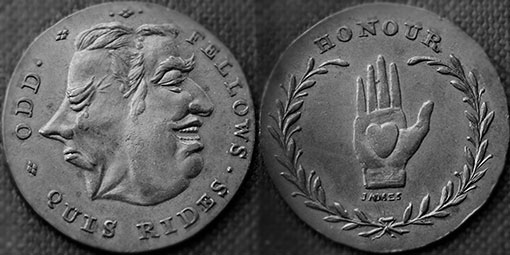Always, some new geekery

You know how you’re playing a Dungeons ‘n’ Dragons kind of computer game, and you buy some food, and it’s, like, five gold pieces? Congratulations! You’ve just paid seven million bucks for a turnip!
Making currency denominations match real life experience was a recurring problem since the Middle Ages, at least. A gold piece was more than a peasant was likely to earn in a lifetime. A copper piece more than a week’s wages. So how the hell was the poor bastard supposed to buy a bowl of soup?
The value of a coin was wedded to the value of the metal it was made from until — well, until we were kids. Remember getting a silver dime or quarter in your change? Early coins were often scored with a cross, so they could be cut into quarters and the quarters spent separately. Copper coins were of the least value, and still people shaved lumps off them and melted them down to make counterfeits.
And still official government coins were in very short supply. Lack of coins in the lowest denominations became an acute problem in the middle 18th C, when more and more people were leaving the land to work in town and couldn’t be paid their wages in pig faces and corn shucks. By 1786, two-thirds of the coins in circulation were fake, and the Royal Mint responded by…wait, shutting itself down? The government refused to strike any copper coins at all in their own right for 48 years, from 1773 until 1821.
But capitalism finds a way. In 1768, one of the largest veins of copper in the world was found in Parys Mountain, Wales. Within twenty years — having failed to sell their anti-counterfeit coin ideas to the government — the Parys Mine Company was making and minting their own copper half pennies to pay their workers. These weren’t regarded as fake anything, as they didn’t pretend to be government issued and were valued based on the weight of the metal. Within a few years, thousands of such half pennies were designed and circulated by individuals, companies, towns, organizations, taking the heat off government.
They were instant collectibles — which explains why there are still so many to be had today in excellent condition. Because they were privately made, the designs range from beautiful to political to goofy. One of the very first collectors and cataloguers was a man named James Conder (1761–1823), hence halfpenny tokens are called Conder Tokens (often misspelled “Condor” on eBay, be advised). By the early 19th C, the government got back in the coin business and outlawed private tokens. The vast majority of private halfpennies bear a date in the 1790s.
Do I collect Conder Tokens? Um, kind of. I collect pictures of the ones I like from eBay. The one at top was designed by the Oddfellows (and it can be yours for a newly discounted price of £42.49!). Many can be had for much less, though, and I’m sorely tempted when local coins come up for sale.
Whenever I think I have discovered all the geekery there is…
Posted: September 10th, 2015 under britain, coins, personal.
Comments: 10
Comments
Comment from Uncle Al
Time: September 11, 2015, 1:52 am
It just so happens I have book to recommend: George Selgin’s Good Money. This is about the monetary problems and solutions, not so much the aesthetics of the coins, but the account is quite fascinating. Early button-manufacturing machinery was modified in some cases to make the coins cheaply and efficiently.
Comment from mojo
Time: September 11, 2015, 4:14 am
Parys also made “African Trade” copper bracelets, which were exchanged for slaves in W. Africa.
Comment from mojo
Time: September 11, 2015, 4:16 am
PS: I want some of those hammered coins you saw at the feta (or whatever) that time.
Comment from ✯☭ Новороссия ☭✯
Time: September 11, 2015, 5:27 am
How’s the Invasion of Europe looking?
Comment from Paul Moore
Time: September 11, 2015, 9:53 am
I’m probably telling everyone something they already know here. There are many private mints operating today that produce silver “rounds” (can’t call them coins). The prices range from “Are you kidding me?” to a slight premium over spot. I usually buy old U.S. junk silver coins at the local coin shop, but picked up a few rounds online that were just too goshdurned purty to ignore.
The silver quarter that would have bought me a gallon of gas in ’64 is worth about a gallon and a half today.
Comment from Wolfus Aurelius
Time: September 11, 2015, 1:35 pm
The Latin on the left coin: Does it mean “Who Laughs?”
Comment from S. Weasel
Time: September 11, 2015, 6:35 pm
I assumed that’s what it meant, Wolfus.
That looks excellent, Uncle Al. And yeah, the variety and quality of these coins is astonishing. If I had the monies, I’d be a proper collector…though pictures will do me for now.
I knew about junk silver, Paul. I didn’t know about ’rounds’. I’ve always been dubious that — come the zompocalypse — anyone would give a shit about precious metals, but an awful lot of people are betting otherwise. They minted silver dimes in the billions, with a b, and they’re 99% pure.
Comment from Uncle Al
Time: September 11, 2015, 9:24 pm
Respectful correction: most “junk silver” US coins are 90% silver, not 99%. There are some exceptions: Eisenhower and Kennedy post-64 were 40% for a while before being debased totally.
Rule of thumb: Junk silver coins totalling one face dollar contain 0.715 troy ounces of silver. So, a non-numismatic silver quarter, with a spot silver price of $14.50/oz, contains silver worth about $2.60 unless it has significant wear. Junk silver in any quantity is sold by weight more often than face value because the coins are usually a bit light due to wear.
As for these coins being worth anything when TSHTF, what will likely happen is that gold and silver will be the fallback medium of exchenge when the dollar crashes, but if things get really, really bad, then ammunition and antibiotics will replace the coins.
Comment from ✯☭ Новороссия ☭✯
Time: September 12, 2015, 6:35 am
https://www.youtube.com/watch?feature=player_embedded&v=0XHhV1LRPBc
Comment from unkawill
Time: September 14, 2015, 12:13 am
https://accordingtohoyt.files.wordpress.com/2015/08/image19.jpg











Write a comment
Beware: more than one link in a comment is apt to earn you a trip to the spam filter, where you will remain -- cold, frightened and alone -- until I remember to clean the trap. But, hey, without Akismet, we'd be up to our asses in...well, ass porn, mostly.<< carry me back to ol' virginny